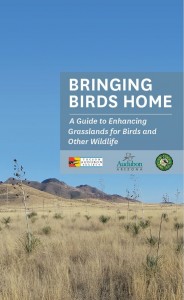The Arizona Important Bird Areas Program along with its partners, Arizona Game and Fish, Tucson Audubon, Audubon Arizona present two Habitat Management Guides. Below are links to PDFs for both the Grasslands guide and the Riparian Guide. There is a third and final guide coming in the near future focusing on Desert habitat. These guides would not have been possible without the support of the following partners: Sonoran Joint Venture, Arizona Antelope Foundation, National Fish and Wildlife Foundation, SRP, and National Audubon Society’s Western Water Initiative.
Bringing Birds Home: A Guide to Enhancing Grasslands for Birds and Other Wildlife
Why Birds?
Because birds are relatively conspicuous and easy to observe (compared to other animals), they are ideal indicators for monitoring environment alchange. Most birds have specific habitat requirements, and changes in habitat can result in changes in the birds that use the area. Arizona is amazingly diverse—from mountains and moist canyons to grasslands and deserts. These different places generate astonishingly high animal diversity. Arizona is famous for our number of native bird species. In fact, according to a study conducted by Natureserve (natureserve.org/library/stateofunions.pdf) Arizona ranks third in the country for the most bird species (and that’s while landlocked). The grasslands, especially in the southeastern part of the state, provide a home for a unique assortment of birds.
This guide will help you create healthy grasslands for birds and other wildlife, as well as people.
Healthy grasslands stabilize soils to moderate soil erosion, help keep water tables high, contribute to healthy water quality, and provide a biologically rich environment. Grasslands can be a source of forage for cattle and other livestock and are an important part of Arizona’s agriculture economy.
Bringing Birds Home: A guide to Enhancing Rivers, Streams and Desert Washes for Birds and Other Wildlife.
Arizona contains amazingly diverse habitats—from mountains with moist canyons to grasslands to parched deserts. Many kinds of plants and animals call these habitats home; the sheer variety of habitats helped Arizona become world famous for the number of bird species found in the state. In an arid environment, the water and rich vegetation along Arizona’s rivers, creeks, wetlands, lakes, ponds, and washes (riparian areas) draw in the highest diversity of birds. This guide aims to help landowners and residents who live along riparian areas to conserve, enhance, and restore habitat specifically to benefit birds. In so doing, you will also create habitat for an incredible variety of mammals, reptiles, amphibians, and insects.
Your actions will help ensure Arizona’s waterways remain healthy.
Keeping riparian areas healthy is important for many reasons:
• Riparian vegetation helps control flood events.
• Stabilizes river banks, traps nutrients and soil, and improves water
quality.
• Improves water quality, provides shade, moderates temperatures,
and helps keep the water table high.
• Riparian areas provide multiple uses and enjoyment to people.






